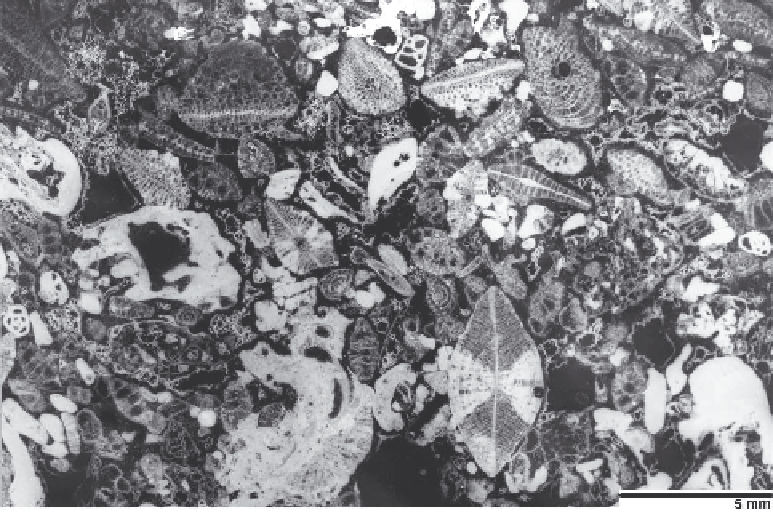Geology Reference
In-Depth Information
Plate 122 Standard Microfacies Type: SMF 18
SMF 18. Bioclastic grainstones and packstones with abundant benthic foraminifera or calcareous green
algae
Criteria
: The main feature of this SMF Type is the high abundance of benthic foraminifera or calcareous
green algae. Other grains are peloids, cortoids and composite grains. Common textures are grainstones and
packstones. Species diversity is low to moderate. The dominant biota should be indicated by additional letters
(SMF 18-F
OR
, foraminifera; SMF 18-D
ASY
, dasyclad algae; SMF 18-U
DO
, udoteacean green algae; SMF 18-
G
YMNO
, gymnocodiacean algae).
Occurrence
: Sediments of SMF 18 occur as bars and channels, and in sand
shoals heaped up by tidal currents in shallow lagoons and bays (restricted platform, FZ 8) and in shelf lagoons
with open circulation (FZ 7). Foraminiferal sands form also in backreef areas and on reef flats (Fig. 14.23).
SMF 18 sediments are common in inner ramp settings.
Additional pictures:
Pl. 57/7 (SMF 18-G
YMNO
), Pl. 57/7
(SMF 18-G
YMNO
), Pl. 61/1 (SMF 18-D
ASY
), Pl. 75/6 (SMF 18-F
OR
), Pl. 105/2 (SMF 18-D
ASY
), Pl. 145/4
(SMF 18-D
ASY
).
1
SMF 18F
OR
.
Foraminiferal grainstone
with abundant miliolids. Miliolid foraminifera are very common in lagoonal
environments (sometimes with elevated salinity) of Mesozoic and Cenozoic restricted inner platforms and inner
ramps. Most associated particles are aggregate grains (AG). The sample comes from a restricted platform lagoon (FZ
8). Late Cretaceous (Albian to Cenomanian): Trnovo, Dinaric Platform, Slovenia.
2
SMF 18D
ASY
.
Dasyclad grainstone
characterized by concentrations of
Spinaporella andalusica
Flügel and Flügel-
Kahler.
Spinaporella
is characterized by long spines. Most of the smaller particles (e.g. bottom center) are broken algal
elements. Note the geopetal infilling of the algal thalli (black arrows). The sample comes from a backreef lagoon behind
a reef formed predominantly of serpulids and synsedimentary carbonate cement. Open-marine platform environment (FZ
7). Late Triassic (Norian): Sierra Nevada near Granada, southern Spain.
3
SMF 18G
YMNO
.
Gymnocodiacean algal packstone
characterized by the concentration of debris of gymnocodiacean
algae (see Sect. 10.2.1.5). The micritic matrix was formed by disintegration of the algae, a mode that corresponds to the
'
Halimeda
model' (see Sect. 4.1.2; Fig. 4.3). The limestone originated in a low-energy, lagoonal inner ramp environment.
Permian (Yeso Formation): Cloudcroft east of Alamogordo, New Mexico, U.S.A.
Fig. 14.23
.
SMF 18F
OR
.
Foraminiferal grainstone.
The massive calcarenite consists of densely packed rotaliid and
lepidocyclinid foraminifera with
Nephrolepidina praemarginata.
The skeletal sand is part of a reef flat situated between the
back reef area and the front of a fringing reef. The strongly varying orientation of the tests, poor sorting and the admixture of
some corallinacean material (grains here white, because negative print!) indicate high-energy deposition by storms. The
sample would be attributed to Facies Zone FZ 7 according to the abundance of benthic foraminifera, but to Facies Zone FZ 5
('reef') if one would only consider the place from where this sample was taken. Negative print. Tertiary (Castro Limestone,
Late Oligocene): Salento Peninsula, southern Italy. After Bosellini and Russo (1992).

